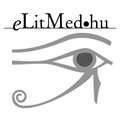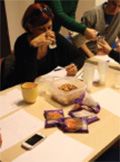The eLitMed.hu medical portal uses computer cookies for convenient operation. Detailed information can be found in the Cookie-policy.
LAM KID - 2014;4(02)
Content
[Diclofenac/orphenadrin as a combined analgetics in relief of pain. Systemic literature review]
[The objectives of this paper are to discuss the safety and tolerability of combined infusion -Neodolpasse(®) - containing nonsteroidal antiinflammarory drug, diclofenac and central muscle relaxant orphenadrin on the basis of recent data. The author reviewed phase IV randomised, controlled studies published on Medline and in the Hungarian literature. On the basis of the available data, diclofenac/orphenadrin infusion is an effective and safe analgesic, which is easy to administer and to combine with other painkillers in acute low back pain and other painful rheumatic conditions, as well as postoperative pain.]
[The effect of biological therapy on generalised osteoporosis in patients with rheumatoid arthritis]
[In rheumatoid arthritis, the inflammation and damage of multiple joints can lead to generalised osteoporosis. This process is mostly mediaated by cells and cytokines that are also important for maintaining inflammation, by inhibiting bone formation as well as stimulating bone resorption. Data from the literature show that biological therapies that effectively decrease inflammation can also stimulate bone formation and inhibit bone resorption. This results in an increased bone density and bone protection, which is highly important to prevent subseqent fractures.]
[Determining sclerostin level in healthy men]
[The aim of this study is to evaluate the relationship of serum sclerostin levels with age, cystatin C, bone mineral density (BMD) and biochemical markers of bone turnover in healthy Hungarian men over 50 years of age. We determined serum levels of sclerostin and examined its relationship with age, cystatin C, osteocalcin, C-terminal telopeptides of type-I collagen, procollagen type 1 amino-terminal propeptide, 25- hydroxyvitamin D, parathyroid hormone, and L1-L4 (LS) and femur neck (FN) BMD data available from 194 randomly selected ambulatory men belonging to the HunMen cohort. In the study population as a whole (n=194; age (median, range): 59 (51-81) years), statistically significant correlation was found between sclerostin and age (r=0.211; p=0.003), cystatin C (r=0.246; p=0.001), FN-BMD (r=0.147; p=0.041) and LS BMD (r=0.169; p=0.019). Compared with middle-aged men (age: ≤ 59 years, n=98), elderly men (age > 59 years, n=96) had significantly higher serum sclerostin levels (67.8±15.9 pmol/l vs. 63.5±14; p=0.047). Among men with normal (T score >-1,0) FN-BMD, the elderly had significantly higher serum sclerostin levels as compared with the middle-aged (70.4±17 pmol/l vs. 63.9±11.5 pmol/l; p=0.019). Furthermore, among the elderly men cystatin C was the only significant predictor of serum sclerostin levels (standardized regression coefficient (béta) = 0,487; p<0,001). Our results show that in the studied healthy elderly cohort sclerostin levels significantly increase with age, along with the deterioration of kidney function as determined by plasma cystatin C levels. ]
[Recognition of the characteristics of rare types of arthritis]
[Recognition of the characteristics of arthritis is crucial for making a correct diagnosis. Several aspects of the history and physical examination could help the diagnosis, such as the mode of onset (acute, insidious), duration of symptoms (self-limiting, chronic), number of affected joints (mono-, oligo-, polyarthritis), distribution of joint involvement (symmetrical, asymmetrical), localisation of affected joints (axial, peripherial) and sequence of involvement (additive, migratory, intermittent). Other important aspects for the correct diagnosis are the characteristics of the patient (gender, age, family history) and the presence or absence of extra-articular features of disease. The articular pattern may change with time in the course of a disease, and the single clinical pattern of joint disease may correspond to more than one diagnosis. Evidence of some distinct articular patterns may limit the spectrum of diagnostic options and reduces unnecessary diagnostic testing. The diagnostic process may require the addition of laboratory examination, imaging techniques, and other tests to refine the analysis. In this article, we report a case where joint punction and histological elucidation was necessary to make the correct diagnosis, because a syndrome of acute, destructive sterile arthritis mimicking articular infection might be present in a variety of joint disorders. In this paper, we highlight those characteristics that are distinctive for particular rheumatological disorders, in order to help starting treatment early.. In a substantial number of patients the cause of the diseases remains undetermined. However, a detailed anamnesis and physical examination remain the cornerstone of a diagnostic evaluation.]
1.
Clinical Neuroscience
[Headache registry in Szeged: Experiences regarding to migraine patients]2.
Clinical Neuroscience
[The new target population of stroke awareness campaign: Kindergarten students ]3.
Clinical Neuroscience
Is there any difference in mortality rates of atrial fibrillation detected before or after ischemic stroke?4.
Clinical Neuroscience
Factors influencing the level of stigma in Parkinson’s disease in western Turkey5.
Clinical Neuroscience
[The effects of demographic and clinical factors on the severity of poststroke aphasia]1.
2.
3.
4.
5.














